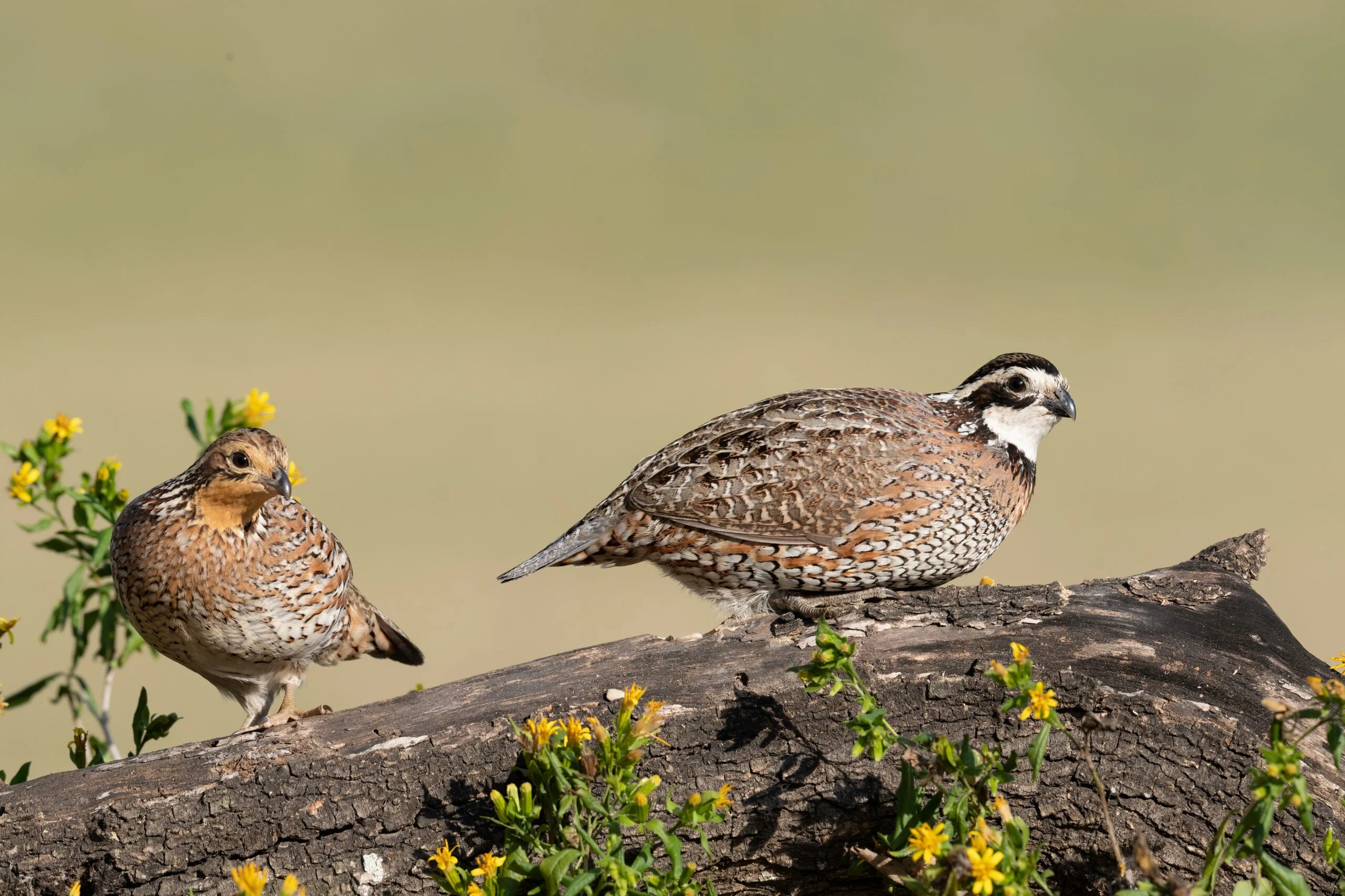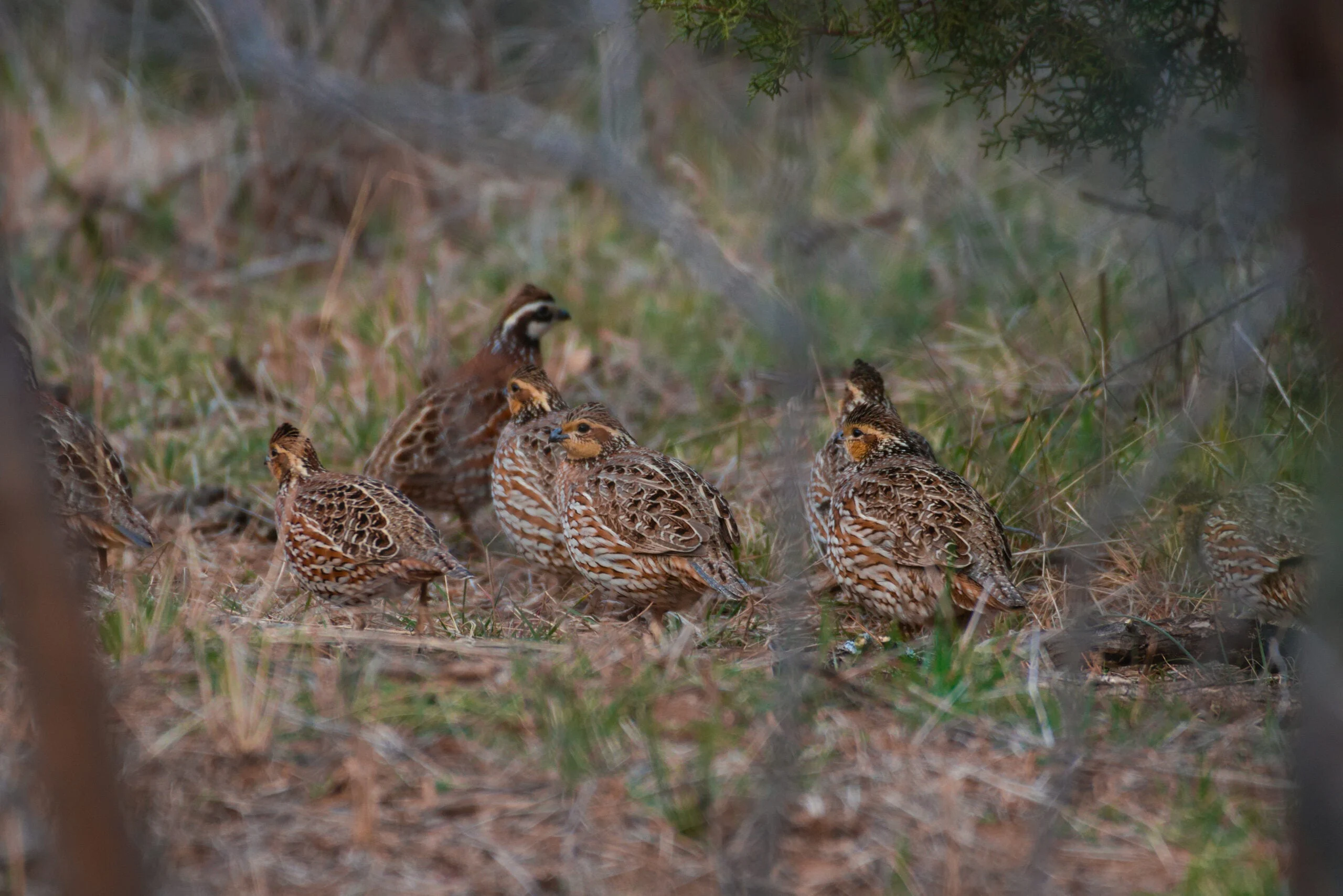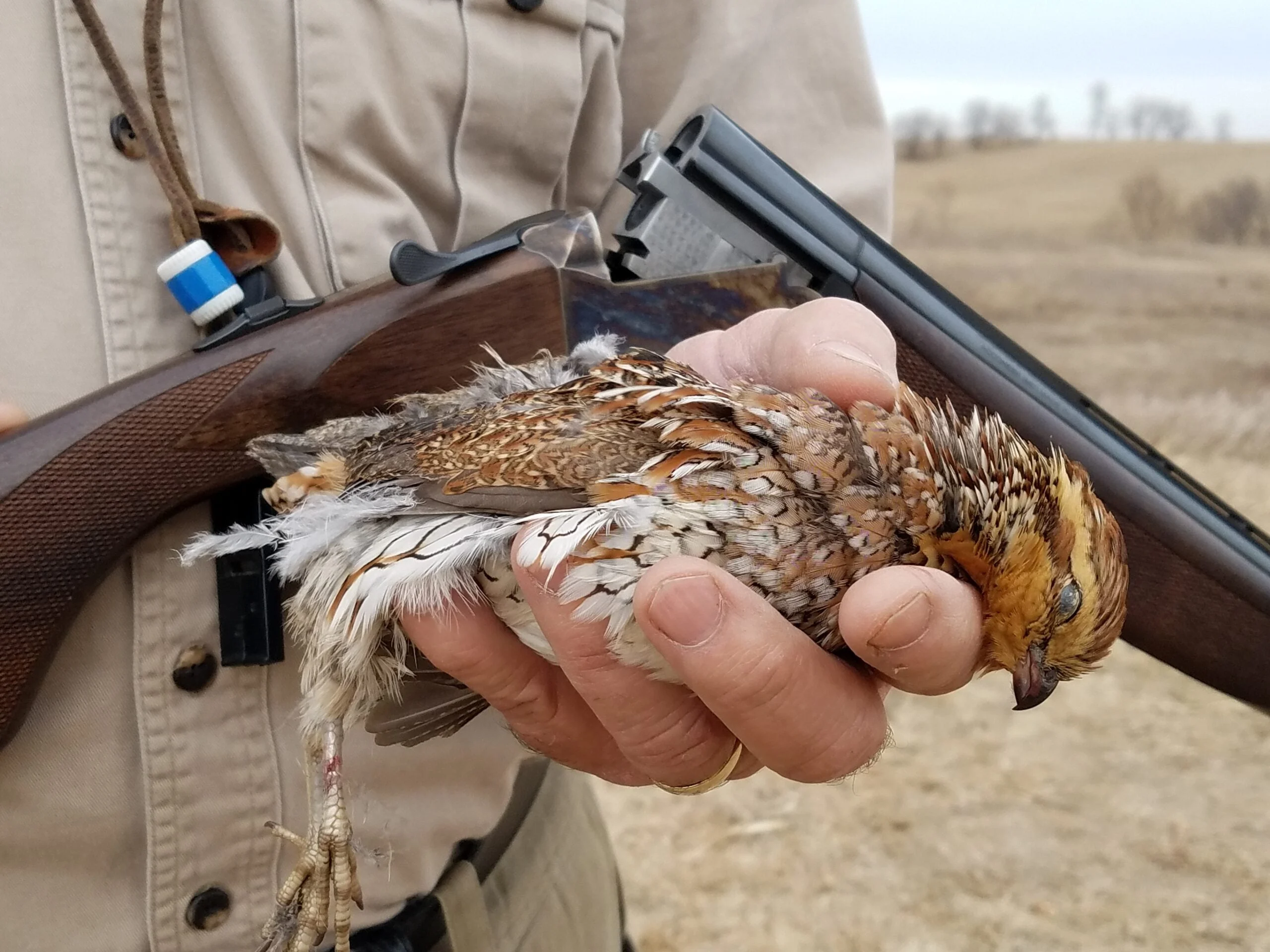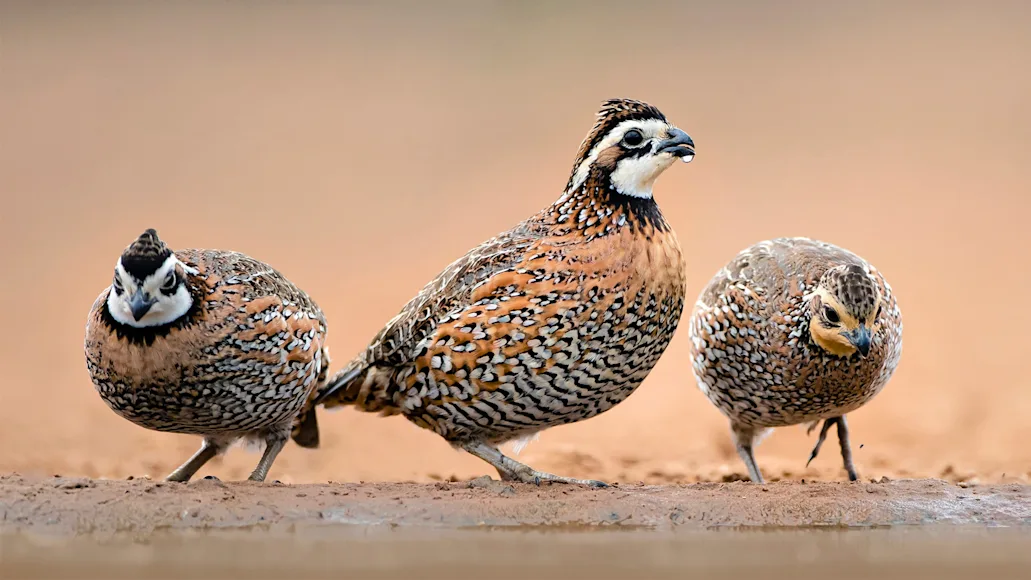_We may earn revenue from the products available on this page and participate in affiliate programs. Learn more ›
_
One of six native quail species found in the United States, the northern bobwhite is the only species found east of the Mississippi. It is named for its two-note whistle, which sounds like a low “Bob” then high “White” call. Although the birds are small at about 6 ounces, their habit of exploding into the air all at once in a covey rise never fails to startle or thrill the person who sees it. A bird of edges and brush, bobwhites were a widespread and popular gamebird throughout the Southeast and adjoining states. The march of modern agriculture has greatly reduced their numbers, but the birds are still populous enough that their “bobwhite” whistle is commonly heard, and many hunters still chase the birds enthusiastically.
Appearance, Range and Habitat
A small, plump bird dressed in brown, buff, black, and white mottling that give it perfect camouflage in its brushy habitat, the bobwhite has distinctive facial markings that differentiate the sexes. The male’s face is black and white, the female’s tan and brown. They have a small, black bill adapted to eating seeds and wide, stubby wings that whir audibly in flight. The only quail native to the eastern part of the United States, bobwhites range from Nebraska east and are found south into Mexico and Cuba.

Female bobwhite quail (left) have tan and brown facial markings, whereas the males’ are a distinctive white and black. Tom / Adobe Stock
Bobwhites need brushy habitat to survive. They are a bird of grass and early successional habitats. They were common in the longleaf pine savannahs of the southeast, and also live in the grass, brush, and cactus of Texas. They are often found around the edges of agricultural fields. Some believe that the clearing of land for small farms in the early 20th century created quail habitat, boosting populations to high levels. The current trend to larger fields and cleaner boundaries is detrimental to quail numbers, as is the conversion of much of the Southeast to dense, unburned pine plantations.
Bobwhite Quail Life History
Bobwhite males will fight for dominance, and both sexes display in the spring to attract mates. The birds were once thought to be completely monogamous, but recent radio-telemetry studies have revealed that males and females aren’t always completely faithful to one another during the breeding season. Bobwhites are hatched from a clutch that averages around a dozen eggs. The male and female work together to scratch out a bowl in the ground, line it with grass, and sometimes cover it to be invisible from above.
Males and females share incubation duties. The chicks hatch after 23 days and stay with the parents as they learn to find food. Hens can re-nest one or more times in the summer, which is one reason bobwhite populations can quickly recover from weather events like ice storms that can devastate quail numbers.

A covey of bobwhites forages for seeds and insects. Gary / Adobe Stock
Quail form coveys of eight to twelve birds. They forage together for seeds, plants, agricultural grains, and insects. A covey will sit in a circle, each bird facing outward, and the whole group will flush together to disorient predators. Alarmed quail rarely fly more than 100 or 150 yards.
Predation and Threats
Hawks, owls, raccoons, opossums, skunks, foxes, feral cats, and snakes eat bobwhites, either by raiding nests, eating the young, or catching adults. Adult quail, like many birds, will pretend to have a broken wing to lead predators away from their chicks. In the fall of the year, humans join the list of bobwhite predators during regulated hunting seasons. Quail coveys need to maintain a certain size to watch for predators and share body heat in cold weather. If predation or hunting reduces numbers too far, quail will try to combine with another covey. Nevertheless, responsible hunters try not to shoot coveys down to a level too low for winter survival.
While quail are not endangered, their numbers have, like those of many farm-country birds, dropped precipitously in the last 50 years. Small farms offered excellent quail cover, and probably even led to an increase in populations over North America’s natural state when they were cleared from the woods or praries. Those farms had plenty of grains and brushy edges and early-succession habitat that quail prefer. Modern agriculture, in which large holdings and fields replaced small farms, has left very little room for bobwhites in much of their range.
Other threats, like fire ants and neonicotinoids, may also be to blame for bobwhite declines. In many places where quail were once commonly seen and hunted, there are virtually no birds left. Even in the Southeast, once a bobwhite stronghold, modern pine plantations and huge soybean fields have replaced long-leaf pine and small farms that once held coveys. Plenty of southerners in their 60s will tell you it was nothing to come home from school, take a gun and a dog, and shoot a limit of quail when they were young. Sadly, that’s no longer possible almost anywhere in the South.
Bobwhite Quail Conservation
Much of the bobwhite’s habitat and former habitat is privately owned. If that land is managed with quail in mind, it’s possible to increase populations. Quail benefit from being a favorite gamebird of the well-to-to, meaning that there are plantations in the Deep South, where quail hunting is a longstanding tradition, as well as ranches in Texas and Oklahoma, where the wealthy owners manage the properties for quail. Aided by Tall Timbers, a quail research foundation in Tallahassee, some southern landowners are managing land with plantings and prescribed burnings that encourage quail comebacks. Elsewhere, quail can benefit from department of agriculture programs, like the Conservation Reserve Program, although their habitat needs are more complex than the large blocks of grassland that are hospitable to ringneck pheasants
.
is the every-hunter’s conservation group, focusing on habitat improvement, lobbying, and land-acquisition for those of us who don’t have plantations of our own. Without wildlife-friendly farm legislation out of Washington, D.C., however, quail will have a difficult time coming back as farming becomes more industrialized.
Bobwhite Quail Hunting

A young hunter shows off a male bobwhite. Steve Oehlenschlager / Adobe Stock
A bobwhite hunt begins with locating good cover. In much of the bird’s range, that typically means hunting in brush or young growth near grain fields. Draws and gullies too steep to clear often hold quail, as do overgrown fencelines, briars patches, and creek bottoms. Open, brushy woods can be hospitable to quail, too, so long as sunlight can reach the forest floor and promote young growth.
While you can hunt quail without a dog by walking and stopping in likely spots to make the birds nervous and cause them to fly, that tactic worked better in years past when quail were more plentiful. Following a good bird dog increases your chances dramatically any time you hunt quail, no matter how numerous they may be. While there are those who will disagree, it’s hard to argue against the pointing breeds over flushers
for quail hunting, both because a pointer gives you time to walk up and get ready for a shot, and because there is not much more exciting in upland hunting than approaching a motionless dog and anticipating a covey rise.
When the birds do flush, take the time to pick out a single quail. Quail are not fast as much as they are small and disorienting, and after you pick a bird, really look at it. Some very good quail shots try to identify whether the bird is a hen or rooster by looking at the head. That tight focus leads the gun to the front end of the bird and aids in clean kills. Be ready after you shoot that first bird, as you may get a second chance. Some coveys flush in waves, and often there’s a straggler, known to quail hunters as “the widow” that follows all the rest.

Being small birds, bobwhite quail call for open-choked shotguns and 7-1/2 or 8 shot. Phil Bourjaily
Since quail don’t go far when they flush, it’s possible to follow up and flush single birds, which can be easier for a lot of people to hit. From a conservation standpoint, you can shoot into a covey you flush late in the day, but you might leave the singles alone so they can relocate one another before dark.
Bobwhite quail are small birds and are most often shot at fairly close range. Any gun with an open choke and small shot such as 7 ½ or 8 lead, or 6 steel is enough for quail, with the possible exception of the .410, unless it’s in the hands of an expert who is also restrained in their shot selection.
Bobwhites are among the best-tasting upland birds, with mild, tender, slightly sweet breast and leg meat that reward frying in butter. And, there is still bobwhite hunting to be found in parts of the U.S., along with the hope that some day we may see these birds come back to their former prominence.






